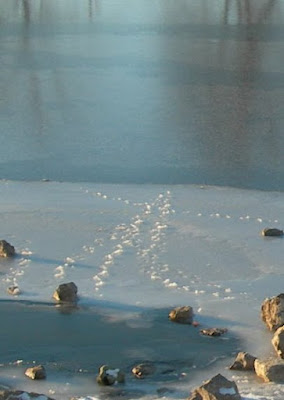 I'm not a WCCO listener, but those who are will, I understand, probably be familiar with Jim Gilbert, who hosts a weekly call-in show called Nature Notes. (You can subscribe to podcasts here -- look for Nature Notes about two-thirds of the way down the page -- and I plan to do that.)
I'm not a WCCO listener, but those who are will, I understand, probably be familiar with Jim Gilbert, who hosts a weekly call-in show called Nature Notes. (You can subscribe to podcasts here -- look for Nature Notes about two-thirds of the way down the page -- and I plan to do that.)Gilbert has taken years of his observations and those shared by his regular contributors and put together a substantial and beautifully illustrated paperback guide to Minnesota phenology called Jim Gilbert's Minnesota Nature Notes: what to look for, week by week throughout the year, with respect to birds, animals, flowers, foliage, crops, precipitation, temperatures, ice-out dates on the lakes, and much more. I love the little downward-tilting nuthatch perching on the "M" of Minnesota on the cover. I look forward to reading this book straight through and then returning to it again and again for reminders of what can be observed around us if we just take the time to notice.
 The Farm to Table Cookbook: The Art of Eating Locally, by Ivy Manning, is a gorgeous hardcover that would look wonderful sitting on a coffee table. Organized seasonally, the book is intended to help those who buy what is fresh and in season and are looking for new and delicious ways to serve those early spring greens, wild mushrooms, orchard fruits or winter squash. As a winter meal, how about Twice Baked Irish Potatoes with Stout [as in Guinness] Onions & Kale?
The Farm to Table Cookbook: The Art of Eating Locally, by Ivy Manning, is a gorgeous hardcover that would look wonderful sitting on a coffee table. Organized seasonally, the book is intended to help those who buy what is fresh and in season and are looking for new and delicious ways to serve those early spring greens, wild mushrooms, orchard fruits or winter squash. As a winter meal, how about Twice Baked Irish Potatoes with Stout [as in Guinness] Onions & Kale? Yet another treat on Christmas day was a snack I bought on a whim at Just Food co-op during its recent anniversary open house: Sing Buri Cashews with dried pineapple, peanuts, lemongrass and Chinese chili, from Sahale Snacks. To tell the truth, I had just about OD'd on nuts this holiday season, and my waistline shows it, but these brought a tangy, zingy, sweet, chewy new quality to rich but heart-healthy nuts, and the pouch is not so big that anyone will go too far overboard on them. Definitely recommended.
Yet another treat on Christmas day was a snack I bought on a whim at Just Food co-op during its recent anniversary open house: Sing Buri Cashews with dried pineapple, peanuts, lemongrass and Chinese chili, from Sahale Snacks. To tell the truth, I had just about OD'd on nuts this holiday season, and my waistline shows it, but these brought a tangy, zingy, sweet, chewy new quality to rich but heart-healthy nuts, and the pouch is not so big that anyone will go too far overboard on them. Definitely recommended.




































